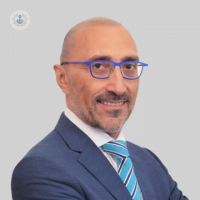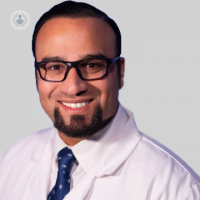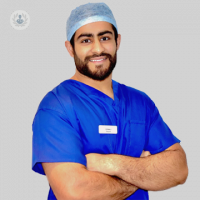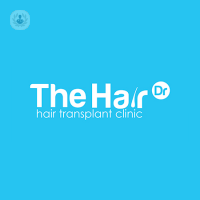What is a hair transplant?
Hair transplantation, sometimes known as a hair graft, is mainly a cosmetic treatment that involves restoring a head of hair using donated hairs which are implanted onto the rest of the scalp. Patients with hair loss and baldness are increasingly turning to hair transplant treatments. There are two main types of hair transplant surgery: follicular unit extraction (FUE) and strip follicular unit transplantation (strip FUT). Hair transplants are often done with local anaesthesia.
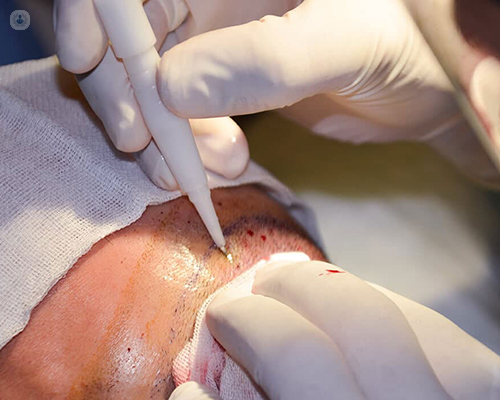
Why is hair transplantation done?
Hair transplants are often chosen by people suffering from hair loss. Hair transplantation can be an option for men with male-pattern baldness, women who have thinning hair, or people who have lost hair due to a burn or injury.
Hair transplants are generally not advised for:
- Women with widespread hair loss
- People with keloid scars on their scalp
- People who have lost their hair due to medication (e.g. from chemotherapy)
- People without enough donor hair sites
What does hair transplantation consist of?
During a FUE hair transplant, a special punch device is used to remove individual hair grafts, one by one. These are then placed into small incisions, hair by hair. During a strip FUT, a strip of hairs and skin are removed, from the back and side of the head. This graft is then stitched onto the recipient site.
Both methods can take up to a day, but staying in hospital is not required. Sometimes, a hair transplant will be carried out in several sessions, especially if there is a large area of hair being transplanted. Local anaesthesia will ensure there is no pain during the procedure.
Preparation for a hair transplant:
Before a hair transplant, it may be necessary to shave a section of your head, however, your surgeon will do this usually.
Aftercare:
Depending on the technique used, aftercare will vary. Following the procedure, you should arrange for someone to take you home as you cannot drive for the first 24 hours. You should be able to return to work two to three days after the procedure. You will have to wear bandages for the first few days, after which, they can be removed. There may be some pain and swelling which can be controlled with anti-inflammatories and painkillers. You may also be given a course of antibiotics to avoid the risk of infection. Usually, after two to three weeks, some hairs will fall out, which is normal, and new hairs will begin to grow in their place. Complete results will be noticeable 8-12 months following your hair transplantation.
11-13-2012 05-03-2023Hair transplant
Dr Bessam Farjo - Aesthetic medicine
Created on: 11-13-2012
Updated on: 05-03-2023
Edited by: Carlota Pano
What is a hair transplant?
Hair transplantation, sometimes known as a hair graft, is mainly a cosmetic treatment that involves restoring a head of hair using donated hairs which are implanted onto the rest of the scalp. Patients with hair loss and baldness are increasingly turning to hair transplant treatments. There are two main types of hair transplant surgery: follicular unit extraction (FUE) and strip follicular unit transplantation (strip FUT). Hair transplants are often done with local anaesthesia.

Why is hair transplantation done?
Hair transplants are often chosen by people suffering from hair loss. Hair transplantation can be an option for men with male-pattern baldness, women who have thinning hair, or people who have lost hair due to a burn or injury.
Hair transplants are generally not advised for:
- Women with widespread hair loss
- People with keloid scars on their scalp
- People who have lost their hair due to medication (e.g. from chemotherapy)
- People without enough donor hair sites
What does hair transplantation consist of?
During a FUE hair transplant, a special punch device is used to remove individual hair grafts, one by one. These are then placed into small incisions, hair by hair. During a strip FUT, a strip of hairs and skin are removed, from the back and side of the head. This graft is then stitched onto the recipient site.
Both methods can take up to a day, but staying in hospital is not required. Sometimes, a hair transplant will be carried out in several sessions, especially if there is a large area of hair being transplanted. Local anaesthesia will ensure there is no pain during the procedure.
Preparation for a hair transplant:
Before a hair transplant, it may be necessary to shave a section of your head, however, your surgeon will do this usually.
Aftercare:
Depending on the technique used, aftercare will vary. Following the procedure, you should arrange for someone to take you home as you cannot drive for the first 24 hours. You should be able to return to work two to three days after the procedure. You will have to wear bandages for the first few days, after which, they can be removed. There may be some pain and swelling which can be controlled with anti-inflammatories and painkillers. You may also be given a course of antibiotics to avoid the risk of infection. Usually, after two to three weeks, some hairs will fall out, which is normal, and new hairs will begin to grow in their place. Complete results will be noticeable 8-12 months following your hair transplantation.


Hair follicle banking: What is it, and is it for me?
By Dr Bessam Farjo
2024-11-08
If you like the idea of your future self thanking your past self for ensuring you have a full head of hair well into older age, you can take advantage of harvesting hair follicles. The Farjo Hair Institute is at the forefront of a ground-breaking cryopreservation treatment for hair loss that uses those banked follicles. Find out more from the clinic's founder, Dr Bessam Farjo. See more


Hair transplant surgery and gender dysphoria: Ask an expert
By Dr Greg Williams
2024-11-08
Hair transplant procedures can offer relief to transgender people experiencing gender dysphoria related to their hairline or hair loss. In this informative article, highly respected hair restoration surgeon Dr Greg Williams explains how hair transplant techniques can benefit people within the gender diversity community. He also offers expert insight on how the hormones used in transitioning can affect hair growth. See more


The role of genetics in determining hair colour
By Dr Nilofer Farjo
2024-11-08
Hair colour is well-known to be an inherited trait from our parents. However, did you know that there's more to it than just 'dominant' and 'submissive' genes? Here to provide a detailed look at hair colour and genetics, is respected hair transplant specialist Dr Nilofer Farjo. See more
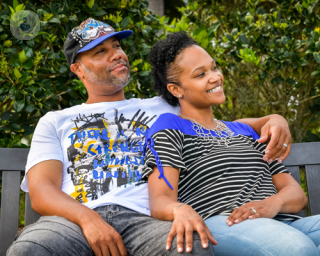

What you need to know about African-Caribbean hair loss
By Dr Nilofer Farjo
2024-11-08
If you want to achieve results that lead to every patient feeling equally happy, a one-size fits all approach to hair loss isn't effective. Leading hair transplant specialist Dr Nilofer Farjo is here to highlight the importance of understanding the nature of African-Caribbean hair loss and its correct diagnosis, in this informative article. See more
Experts in Hair transplant
-
Dr Fas Arshad
Plastic surgeryExpert in:
- Facelift
- Neck lift
- Rhinoplasty (nose job)
- Forehead reduction (hair line lowering)
- Facial plastic surgery
- Hair transplant
-
Dr Hamza Ahmed
Aesthetic medicineExpert in:
- Hair transplant
- FUE hair transplant
- Hair loss
- Forehead reduction (hair line lowering)
- Micrograft hair transplant
- Anti-ageing treatments
-
Dr Eleojo Achimugu
Aesthetic medicineExpert in:
- Hair loss
- Hair transplant
- FUE hair transplant
- Forehead reduction (hair line lowering)
- Male pattern baldness
- Micrograft hair transplant
-
Dr Vikas Kunnure
Aesthetic medicineExpert in:
- Hair loss
- Hair transplant
- FUE hair transplant
- Micrograft hair transplant
- Male pattern baldness
- Alopecia
-
Dr Amy Vowler
Aesthetic medicineExpert in:
- FUE hair transplant
- Platelet-rich plasma
- Hair transplant
- Hair loss
- See all

The Hair Dr
The Hair Dr
78 Bradford Road
No existe teléfono en el centro.
By using the telephone number provided by TOP DOCTORS, you automatically agree to let us use your phone number for statistical and commercial purposes. For further information, read our Privacy Policy
Top Doctors

The Mae Clinic
The Mae Clinic
10 Harley Street, Marylebone, London W1G 9PF
No existe teléfono en el centro.
By using the telephone number provided by TOP DOCTORS, you automatically agree to let us use your phone number for statistical and commercial purposes. For further information, read our Privacy Policy
Top Doctors
-
The Hair Dr
78 Bradford Road, DewsburyExpert in:
- Hair transplant surgery
- Plastic surgery, reconstructive and aesthetics
- Hair restoration
- FUE hair transplant
-
The Mae Clinic
10 Harley Street, Marylebone, London W1G 9PF, W1G Marylebone LondonExpert in:
- Hair transplant surgery
- Paediatrics
- Hair loss
- Platelet-rich plasma
- Hair restoration
- FUE hair transplant
- See all
- Most viewed diseases, medical tests, and treatments
- Nutrition
- Weight loss injections
- Endermologie
- Polynucleotides
- Nipple discharge
- Abdominal pain
- Endovenous laser treatment (EVLA)
- Minimal access surgery (keyhole surgery)
- Head and neck cancer
- Neck lump
